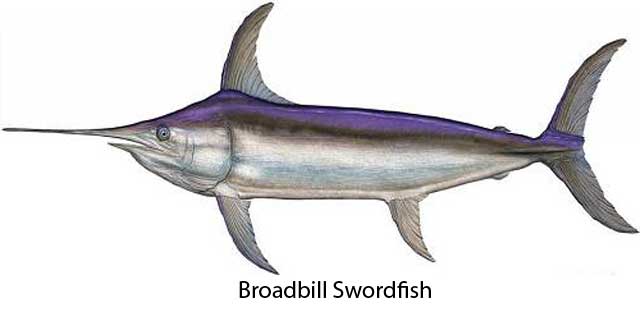
BROADBILL SWORDFISH

Xiphias gladius
Spanish: Pez Espada
The Swordfish is characterized by its robust body, and long bill, with a flattened cross-section, that is approximately one-third of the fish's length. The Swordfish has dark brown upper sides which fade to light brown underneath and its fins are brown to black-brown.
It has large black eyes, no teeth, no pelvic fins, a single keel on each side of the tail base, and pectoral fins that originate on the lower sides. Its first dorsal fin is rigid, with a short base and a pointed apex, and it is well separated from the second dorsal fin.
This is a highly prized game and commercial species that is exceedingly difficult to catch by anglers. The Swordfish spends the evening near the surface but days at depths between 1,000 feet and 2,000 feet in the water column incurring a temperature drop of almost 20 degrees Centigrade. It has a broader temperature tolerance than other billfish, and is thus considered to be more temperate than tropical with a wider horizontal and vertical distribution than all other billfishes. The Swordfish is never found in water less than 600 feet deep. It feeds on mackerel, mullet, small tuna and live squid. Most recreational catches are made at night on live squid using a light.
The Broadbill Swordfish is not easy to confuse with other species due to its long flat sword, short dorsal fin base, and single keel.
The old tried and tested internationally accepted way to catch broadbill is to drift at night and set a range of baits at various depths ranging from 20-150m below the surface. Squid, mackerel or small tuna are the preferred baits. Anglers looking to cover more water adopt slow trolling methods to do this. Slow trolling is carried out at boat idle speed and a whole squid, tuna, or a fresh belly flap, is rigged behind a softhead skirted trolling lure and then set to swim deep using breakaway sinkers or a downrigger.
The strike of a broadbill is a bit different to what you might expect from such a large and powerful fish. Often it’s a slow clicking of the reel as the fish takes the bait, increasing gradually as the broadbill picks up speed. But a word of caution here; the mouth of a broadbill is quite soft in parts so quite a few fish come unstuck early in the piece leaving anglers shaking, bewildered and wondering what might have been.
The Broadbill Swordfish grows to over 4.5 metres and over 600kg.
Broadbill swordfish are oceanic fish distributed through tropical and temperate waters of the Pacific, Indian and Atlantic oceans.